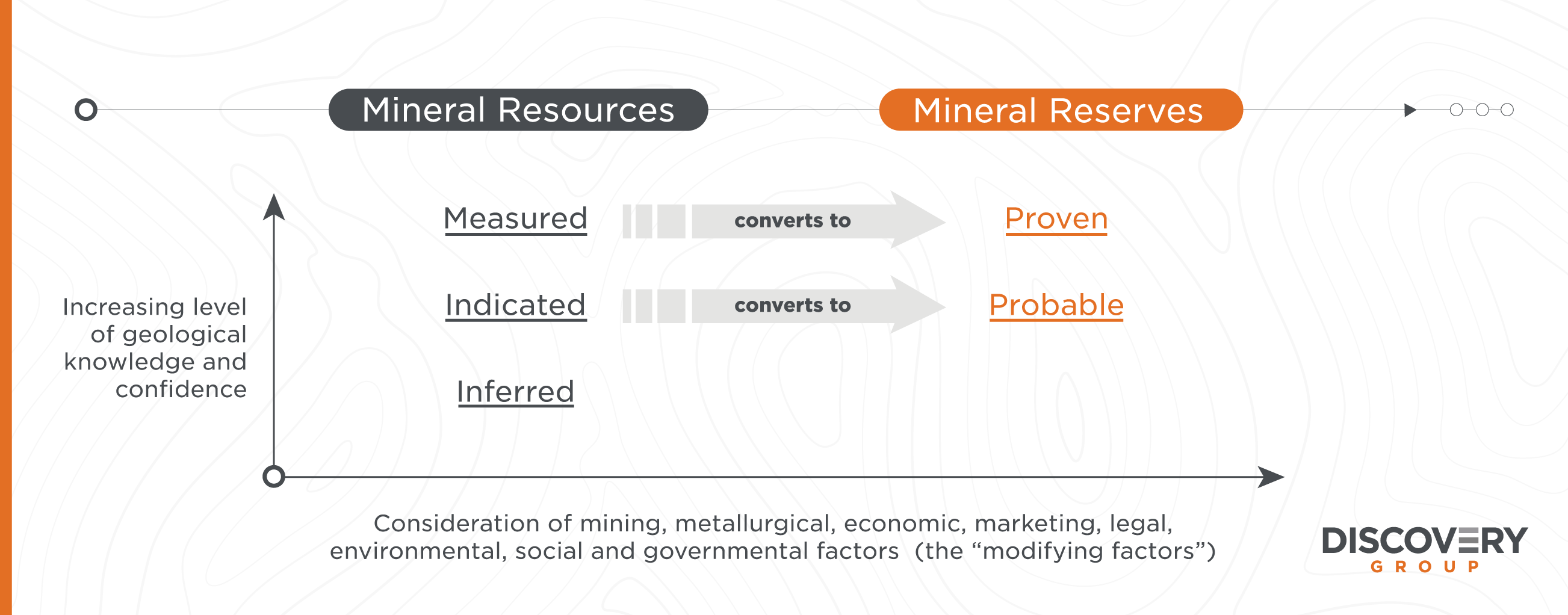Understanding Mineral Resources & Reserves
Mineral resources and reserves are estimates of the grade and tonnage of economically interesting mineralization present in a mineral deposit. The calculation of grade and tonnage is a crucial benchmark for exploration or mining companies, as they provide essential information to evaluate the economic viability of initiating a mining operation.
The following terms are used to classify mineral resources or reserves:
- Inferred, Indicated or Measured Mineral Resource
- Probable or Proven Mineral Reserve
Figure 1: The mineral resource and mineral reserve terminology adopted by most major mining jurisdictions

Mineral Resource
A mineral resource refers to a mineral deposit that is large enough and has sufficient grade of valuable materials that, under reasonable assumptions, could be mined at a profit.
Mineral resources are categorized into Inferred, Indicated and Measured mineral resources in order of increasing geological knowledge and confidence:
- Inferred Mineral Resource
This is the portion of the mineral resource that has been estimated based on limited sampling and where there is reasonable, but not yet verified, assurance of continuity of mineralization and grade among samples.
Due to the relatively low level of confidence in an Inferred Mineral Resource, it cannot serve as the foundation for a pre-feasibility or feasibility study, and thus, it can’t be converted to a mineral reserve.
- Indicated Mineral Resource
This is the portion of the mineral resource that has been estimated based on reliable and detailed sampling from drill holes that are too widely spaced to confirm continuity of mineralization and grade. However, the holes are close enough for there to be reasonable assurance of continuity of mineralization and grade.
The confidence level in an Indicated Mineral Resource is sufficient to serve as the foundation for engineering and economic studies.
- Measured Mineral Resource
This is the portion of the mineral resource that has been estimated with a high level of confidence based on reliable and detailed sampling from drill holes that are spaced close enough to confirm the continuity of mineralization and grade. Measured Mineral Resources more than sufficiently serve as the foundation for engineering and economic studies.
When mineral resources are reported by exploration or mining companies, Inferred Mineral Resources can’t be combined with Indicated or Measured Mineral Resources. Where Measured and Indicated Mineral Resources are combined, (commonly referred to as “M&I Mineral Resources”), they must be reported separately.
Figure 2: Defense Metals’ Mineral Resource Estimates for the Wicheeda Rare Earth Elements Project (See News Release Dated Sept 12, 2023).

Defense’s 2023 MRE comprises a 6.4 million tonne Measured Mineral Resource, averaging 2.86% (TREO)*; 27.8 million tonne Indicated Mineral Indicated Resource, averaging 1.84% TREO; and 11.1 million tonne Inferred Mineral Resource, averaging 1.02% TREO, reported at a cut-off grade of 0.5% TREO.
* Total rare earth oxide, sum of 10 oxides: CeO2, La2O3, Nd2O3, Pr6O11, Sm2O3, Eu2O3, Gd2O3, Tb4O7, Dy2O3 and Ho2O3.
Mineral Reserve
A mineral reserve is the economically mineable portion of a Measured or Indicated Mineral Resource demonstrated by at least a preliminary feasibility study.
Unlike a resource, which is predominantly determined by the geology of a deposit, a reserve is the economically mineable part of the resource, considering all the “modifying factors” listed in Figure 1. Essentially, the conversion from a mineral resource to a mineral reserve occurs once the engineering and economics of a potential mine have been established. Mineral reserves are categorized as Probable or Proven.
Typically, Indicated Mineral Resources are converted to Probable Mineral Reserves, while Measured Mineral Resources are transformed into Proven Mineral Reserves. In instances where the modifying factors are insufficiently known, Measured Mineral Resources might be converted to Probable Mineral Reserves.
Additionally, there exists the possibility of reverting reserves back to resources if there is a significant change in the modifying factors. For instance, a reassessment revealing a significant increase in capital costs for constructing a mine, beyond the initial estimates, may render the reserve no longer economically viable under current conditions, leading it to revert back to a resource.
In conclusion, understanding mineral resources and reserves is crucial for investors seeking a clear understanding of a mineral exploration or mining project's economic potential. The categorization, ranging from Inferred to Measured resources and Probable to Proven reserves, provides valuable insights into the project's feasibility and risk levels. Additionally, the conversion process from resources to reserves, contingent on modifying factors and economic feasibility, directly impacts the project's investment outlook. In essence, a savvy investor leverages this information to make well-informed decisions, navigating the dynamic landscape of mining investments with a clearer understanding of potential risks and returns.

